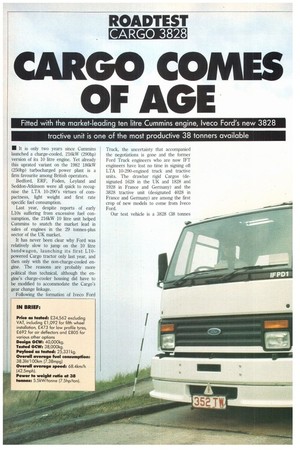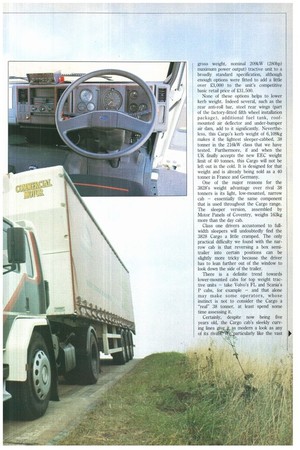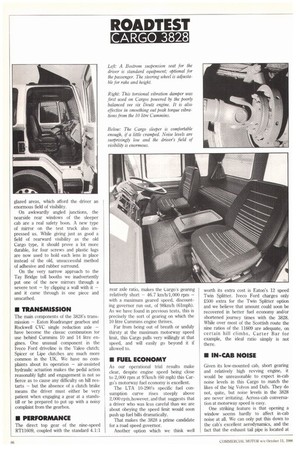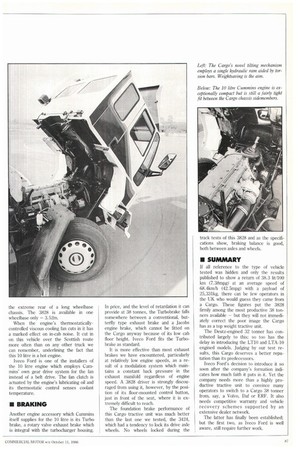CARGO COMES OF AGE
Page 82

Page 83

Page 84

Page 85

If you've noticed an error in this article please click here to report it so we can fix it.
Fitted with the market-leading ten litre Cummins engine, lveco Ford's new 3828 tractive unit is one of the most productive 38 tonners available
IN It is only two years since Cummins launched a charge-cooled, 216kW (290hp) version of its 10 litre engine. Yet already this uprated variant on the 1982 186kW (250hp) turbocharged power plant is a firm favourite among British operators.
Bedford, ERF, Foden, Leyland and Seddon-Atkinson were all quick to recognise the LTA 10-290's virtues of compactness, light weight and first rate specific fuel consumption.
Last year, despite reports of early LlOs suffering from excessive fuel consumption, the 216kW 10 litre unit helped Cummins to snatch the market lead in sales of engines in the 29 tonnes-plus sector of the UK market.
It has never been clear why Ford was relatively slow to jump on the 10 litre bandwagon, launching its first L10powered Cargo tractor only last year, and then only with the non-charge-cooled engine. The reasons are probably more political than technical, although the engine's charge-cooler housing did have to be modified to accommodate the Cargo's gear change linkage.
Following the formation of Iveco Ford Truck, the uncertainty that accompanied the negotiations is gone and the former Ford Truck engineers who are now IFT engineers have lost no time in signing off LTA 10-290-engined truck and tractive units. The drawbar rigid Cargos (designated 1628 in the UK and 1828 and 1928 in France and Germany) and the 3828 tractive unit (designated 4028 in France and Germany) are among the first crop of new models to come from lveco Ford.
Our test vehicle is a 3828 (38 tonnes gross weight, nominal 209kW (280hp) maximum power output) tractive unit to a broadly standard specification, although enough options were fitted to add a little over £3,000 to the unit's competitive basic retail price of £31,500.
None of these options helps to lower kerb weight. Indeed several, such as the rear anti-roll bar, steel rear wings (part of the factory-fitted fifth wheel installation package), additional fuel tank, roofmounted air deflector and under-bumper air dam, add to it significantly. Nevertheless, this Cargo's kerb weight of 6,109kg makes it the lightest sleeper-cabbed, 38 tonner in the 216kW class that we have tested. Furthermore, if and when the UK finally accepts the new EEC weight limit of 40 tonnes, this Cargo will not be left out in the cold. It is designed for that weight and is already being sold as a 40 tanner in France and Germany.
One of the major reasons for the 3828's weight advantage over rival 38 tonners is its light, low-mounted, narrow cab — essentially the same component that is used throughout the Cargo range. The sleeper version, assembled by Motor Panels of Coventry, weighs 163kg more than the day cab.
Class one drivers accustomed to fullwidth sleepers will undoubtedly find the 3828 Cargo a little cramped. The only practical difficulty we found with the narrow cab is that reversing a box semitrailer into certain positions can be slightly more tricky because the driver has to lean further out of the window to look down the side of the trailer.
There is a definite trend towards lower-mounted cabs for top weight tractive units — take Volvo's FL and Scania's P cabs, for example — and that alone may make some operators, whose instinct is not to consider the Cargo a "real" 38 tonner, at least spend some time assessing it.
Certainly, despite now being five years old, the Cargo cab's sleekly curv
ing lines giv as modern a look as any of its riva.particularly like the vast
glazed areas, which afford the driver an enormous field of visibility.
On awkwardly angled junctions, the nearside rear windows of the sleeper cab are a real safety boon. A new type of mirror on the test truck also impressed us. While giving just as good a field of rearward visibility as the old Cargo type, it should prove a lot more durable, for four screws and plastic lugs are now used to hold each lens in place instead of the old, unsuccessful method of adhesive and rubber surround.
On the very narrow approach to the Tay Bridge toll booths we inadvertently put one of the new mirrors through a severe test — by clipping a wall with it — and it came through in one piece and unscathed.
• TRANSMISSION
The main components of the 3828's transmission — Eaton Roadranger gearbox and Rockwell CVC single reduction axle — have become the classic combination tor use behind Cummins 10 and 14 litre engines. One unusual component in the Iveco Ford dtiveline is the Vale° clutch; Spicer or Lipe clutches are much more common in the UK. We have no complaints about its operation — air-assisted hydraulic actuation makes the pedal action reasonably light and engagement is not so fierce as to cause any difficulty on hill restarts — but the absence of a clutch brake means the driver must either be very patient when engaging a gear at a standstill or be prepared to put up with a noisy complaint from the gearbox.
• PERFORMANCE
The direct top gear of the nine-speed RT11609, coupled with the standard 4.1:1 rear axle ratio, makes the Cargo's gearing relatively short — 46.7 km/h/1,000 rpm — with a maximum geared speed, discounting governor run out. of 98km/h (61mph). As we have found in previous tests, this is precisely the sort of gearing on which the 10 litre Cummins engine thrives.
Far from being out of breath or unduly thirsty at the maximum motorway speed limit, this Cargo pulls very willingly at that speed, and will easily go beyond it if allowed to.
• FUEL ECONOMY
As our operational trial results make clear, despite engine speed being close to 2,000 rpm at 97km/h (60 mph) this Cargo's motorway fuel economy is excellent.
The LTA 10-290's specific fuel consumption curve rises steeply above 2,000 rpth, however, and that suggests that a driver who was less careful than we are about obeying the speed limit would soon push up fuel bills dramatically.
That makes the 3828 a prime candidate for a road speed governor.
Another option which we think well worth its extra cost is Eaton's 12 speed Twin Splitter. Iveco Ford charges only 50() extra for the Twin Splitter option and we believe that amount could soon be recovered in better fuel economy and/or shortened journey times with the 3828. While over most of the Scottish route the nine ratios of the 11609 are adequate, on certain hill climbs, Carter Bar for example, the ideal ratio simply is not there.
• IN-CAB NOISE
Given its low-mounted cab, short gearing and relatively high revving engine, it would be unreasonable to expect in-cab noise levels in this Cargo to match the Likes of the big Volvos and Dafs. They do not, quite, but noise levels in the 3828 are never irritating. Across-cab conversation at motorway speed is easy.
One striking feature is that opening a window seems hardly to affect in-cab noise at all. We can only put this down to the cab's excellent aerodynamics, and the fact that the exhaust tail pipe is located at the extreme rear of a long wheelbase chassis. The 3828 is available in one wheelbase only — 3.52m.
When the engine's thermostaticallycontrolled viscous cooling fan cuts in it has a marked effect on in-cab noise. It cut in on this vehicle over the Scottish route more often than on any other truck we can remember, underlining the fact that this 10 litre is a hot engine.
Iveco Ford is one of the installers of the 10 litre engine which employs Cummins' own gear drive system for the fan instead of a belt drive. The fan clutch is actuated by the engine's lubricating oil and its thermostatic control senses coolant temperature.
• BRAKING
Another engine accessory which Cummins itself supplies for the 10 litre is its Turbo brake, a rotary valve exhaust brake which is integral with the turbocharger housing. In price, and the level of retardation it can provide at 38 tonnes, the Turbobrake falls somewhere between a conventional, butterfly type exhaust brake and a Jacobs engine brake, which cannot be fitted on the Cargo anyway because of its low cab floor height. Iveco Ford fits the Turbobrake as standard.
It is more effective than most exhaust brakes we have encountered, particularly at relatively low engine speeds, as a result of a modulation system which maintains a constant back pressure in the exhaust manifold regardless of engine speed. A 3828 driver is strongly discouraged from using it, however, by the position of its floor-mounted control button, just in front of the seat, where it is extremely difficult to reach.
The foundation brake performance of this Cargo tractive unit was much better than the last one we tested, the 3424, which had a tendency to lock its drive axle wheels. No wheels locked during the
track tests of this 3828 and as the specifications show, braking balance is good, both between axles and wheels.
III SUMMARY
If all reference to the type of vehicle tested was hidden and only the results published to show a return of 38.3 lit/100 km (7.38mpg) at an average speed of 68.4km/h (42.5mpg) with a payload of 25,331kg, there can be few operators in the UK who would guess they came from a Cargo. These figures put the 3828 firmly among the most productive 38 tonners available — but they will not immediately correct the poor image the Cargo has as a top weight tractive unit.
The Deutz-engined 32 tonner has contributed largely to this; so too has the delay in introducing the LT10 and LTA-10 engined models. Judging by our test results, this Cargo deserves a better reputation than its predecessors.
Iveco Ford's decision to introduce it so soon after the company's formation indicates how much faith it puts in it. Yet the company needs more than a highly productive tractive unit to convince many operators to switch to a Cargo 38 tonner from, say, a Volvo, Daf or ERE. It also needs competitive warranty and vehicle recovery schemes supported by an extensive dealer network.
The latter has finally been established; but the first two, as Iveco Ford is well aware, still require further work.
























































































































